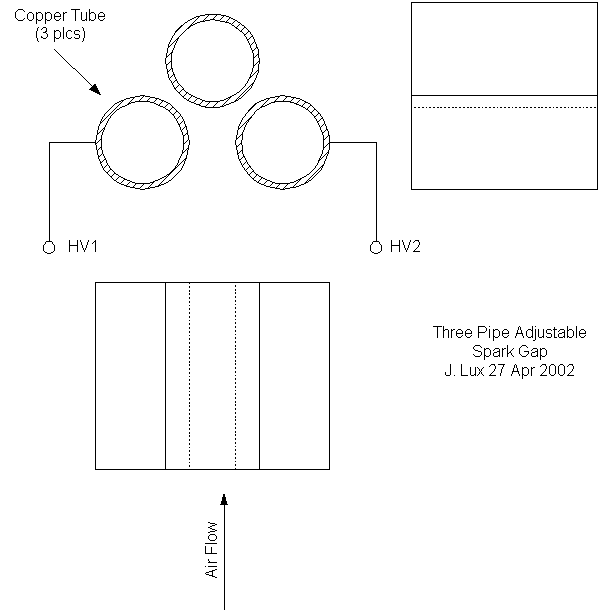 (click to display larger GIF)
(click to display larger GIF)Invented by Nikola Tesla in the 19th century, and much beloved of science fiction film makers of the 30's and 40's, as well as hv experimenters of today, the Tesla coil is an inexpensive way to generate very high voltages (hundreds of kV, at least) at low radio frequencies. A tesla coil is basically an air core transformer or two coupled inductors with capacitors chosen to resonate at the same frequency, typically a few hundred kHz. In the classic spark gap coil, the low voltage primary is driven as a spark gap oscillator: a transformer with 5-20kV charges the capacitor, and when the voltage gets high enough, the gap breaks down, forming a LC resonant circuit. The energy is coupled out of the primary LC into the secondary LC (typically with a coupling coefficient around 0.1 to 0.2). Since the secondary has much higher L and much smaller C, the voltage is higher, for the same energy.
There is an immense amount of information on Tesla coils available on the web, some of it good, some of it positive dreck. Start at the Tesla Coil Mailing List: http://www.pupman.com/, which has great (searchable) archives, and some helpful design spreadsheets.
Basic design is simple, and optimization is really a matter of choosing values that are convenient and buildable. You want low loss in your spark gap. You want the coupling to be such that the energy transfers from primary to secondary as the spark from the secondary grows, otherwise, the voltage on the secondary rises too fast, and you get the dreaded "racing sparks" down the secondary coil.
Here is a simple 3 pipe static gap which I have found works pretty well, especially with a muffin fan blowing the length of the pipes. It's easily adjustable and has good thermal properties. It's a whole lot better than the "two bolts" kind of gap which a lot of people start with. That particular gap winds up getting hot and having problems "quenching" (i.e. you want the gap to stop conducting, so that the primary capacitor can charge again)
Photos of 3 tube gap: tubegap1x.jpg tubegap3x.jpg
Several people have built blast gaps and/or triggered gaps for Tesla coils, some based on the pages here. And, of course, the ever popular rotary gap.
Standard formulae for inductance are from Wheeler and for capacitance from Medhurst.
Some recent thoughts on modeling the spark growth and some older thoughts on what's going on during the spark
Two pages on grounding of tesla coils: page 1 page 2
Some analysis of EMI from tesla coils.
Copyright 1997, Jim Lux / Back to home page / Mail to Jim